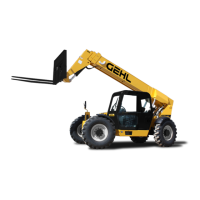PRINTED IN U.S.A. 37 913287/BP0808
Traffic Flow Patterns
For safety, know and understand the traffic flow pat-
terns of your jobsite and the Telescopic Handler hand
signals. Use signal persons and make sure you can see
the signal person and acknowledge the signals given.
Refer to the safety hand signal illustrations on the next
page.
The backup alarm automatically sounds when the trav-
el lever is in Reverse. Care should be taken when down
shifting or reversing because damage to the transmis-
sion can occur if shifting is forced or attempted while
traveling.
When ramps must be used in transporting loads with
the machine, the following shall be the minimum
widths for safe travel:
Compacted dirt, gravel, etc. - 12 ft. (3.6 m)
Woodboard, concrete, etc. - 10 ft. (3 m)
Permanent aisles, roadways, passageways, floors and
ramps should be marked or defined in some fashion.
Permanent or temporary protrusion of loads, equip-
ment, material and construction facilities into the usual
operating area should be guarded, clearly and distinc-
tively marked, or clearly visible.
Maintain a safe distance from the edge of ramps, plat-
forms and other similar working surfaces.
Grade and Slope Precautions
The Telescopic Handler complies with industry stabil-
ity tests requirements and is stable when properly oper-
ated. However, improper operation, faulty mainte-
nance, or poor housekeeping may contribute to a con-
dition of instability and defeat the purpose of the stan-
dard.
The amount of forward and rearward tilt to be used is
governed by the application. Although use of maxi-
mum rearward tilt is allowable under certain condi-
tions, such as traveling with the load fully lowered, the
stability of the machine, as determined by the industry
standard tests, does not encompass consideration for
excessive tilt at high elevations, or the handling of off-
center loads.
Handle only loads within the capacity limits of the
machine, and that are stable and safely arranged. When
attachments are used, extra care should be taken in
securing, manipulating, positioning and transporting
the load.
Grade Limits
NOTE: Grade limits are based on ANSI/ITSDF
standard B56.6-2005.
The telescopic handler meets or exceeds the safety
standard (ANSI/ITSDF B56.6) stability limits for
rough-terrain forklifts. The stability tipping limits
cover specific, controlled test conditions, which are
extremes, and which are not intended to be achieved
during normal worksite operations. The following
specifications are provided only as information to the
operator, and must not be used as a guideline for oper-
ating the telescopic handler. For safe operation,
always follow the instructions and warnings provided
in this manual.
1. DO NOT place or retrieve loads on a up or down
slope or grade that exceeds 7% or 4
o
grade.
2. DO NOT travel up or down a grade or slope that
exceeds 22% or 12
o
grade while loaded.
3. DO NOT place or retrieve loads on a side hill with
a slope or grade that exceeds 12% or 7
o
grade.
Regardless of the terrain or position of the
wheels, the FRAME MUST BE LEVEL, as indi-
cated by the frame angle indicator on the ROPS
crossmember.
4. DO NOT travel across a side hill that exceeds
18% or 10
o
grade. Regardless of the terrain or
position of the wheels, the FRAME MUST BE
WARNING
DO NOT level the frame with the boom raised
or extended. Level the frame ONLY while
stopped, with the boom fully retracted, and
the attachment tool raised just enough to clear
the ground.
LEVEL, as indicated by the frame angle indicator
on the ROPS crossmember. The attachment tool
MUST be maintained at the “carry” position, with
the boom fully retracted, and attachment tool at
minimum ground clearance.
When ascending or descending grades in excess of 5%
or 3
o
, the machine should be driven with the load
upgrade. An unloaded machine should be operated on
all forward grades with the load handling attachment
tool downgrade, tilted back if applicable, and raised
only as far as necessary to clear the road surface. Avoid
turning if possible and use extreme caution on grades,
ramps or inclines. Normally travel straight up and
down.
Courtesy of Crane.Market

